Fostering Impact:
An investor guide for engaging communities in place-based impact investing



Supported by


Fostering Impact: An investor guide for engaging communities in place-based impact investing


An investor guide for engaging communities in place-based impact investing



Supported by


Fostering Impact: An investor guide for engaging communities in place-based impact investing

“Fostering Impact: An investor guide for engaging communities in place-based impact investing” was designed for investors, developers, and stakeholders who want to enhance their impact and financial performance by forging partnerships with local communities through meaningful engagement.
Our guide empowers investors to identify and pursue community engagement opportunities within a place-based impact investment approach, and it lays out different ways and methods of incorporating community engagement into investment decision-making.
Readers will find information, practical steps, and additional resources on the following topics:
• Place-Based Impact Investing (PBII): Gain insights into how investors can deepen their impact and meet performance objectives by directing capital towards underinvested areas for improved living standards and inclusive communities.
• Spectrum of public participation: Learn the levels of engagement, ranging from information sharing, consulting, and involving, to collaboration and empowerment.
• Illustrative examples: Draw insights from real-life cases of emerging practice, showcasing different methods of integrating community engagement in the investment process.
• The significance of community engagement: Understand the pivotal role of community engagement in shaping investment decisions and outcomes.
• Motivations for meaningful engagement: Explore the key drivers for investors to engage with communities in a meaningful and sustainable manner.

• Effective engagement strategies: Discover how to initiate, plan, deliver, and sustain community engagement efforts through diverse engagement methods that require different levels of resourcing.
• Leveraging partnerships: Understand how to engage communities through intermediaries for mutually beneficial outcomes.
• Avoiding common pitfalls: Learn about common pitfalls and how to steer clear of them, such as seeking input after decisions are made or lacking clarity on how to utilise engagement outcomes.
By putting people and communities at the heart of investment decisions, investors can play a critical and much needed role in creating thriving, inclusive, and sustainable communities.
This guide is part of the Impact Investing Institute’s programme of work on placebased impact investing (PBII), supported by the UK Government’s Department for Culture, Media and Sport (DCMS). The programme supports financial institutions to make more investments with the intention to yield positive local impact as well as appropriate riskadjusted financial returns. This guide provides a practical introduction to community engagement for placebased impact investors.
The Impact Investing Institute and Involve have worked together to produce this guide.
The Impact Investing Institute is an independent, non-profit, set up to connect capital to impact. We act as a bridge between new economic ideas and mainstream capital markets to accelerate the impact investing field. We support investors to put impact at the heart of their commercial investment strategies.
We also work with policymakers and civil society to advocate for impact investing as a powerful tool to unlock solutions to the world’s most urgent challenges like climate change and rising inequality.
Involve is the UK’s leading public participation charity, which aims to build a vibrant democracy where everyone can shape a society that works for us all. Involve develops, supports, and campaigns for new ways to involve people in decisions that affect their lives.
The Impact Investing Institute and Involve have brought together their respective domains of expertise – impact investing and community engagement – in order to support both investors and the communities that their work affects in building mutual understanding and constructive ways of working.

The Impact Investing Institute is an independent, non-profit, set up to connect capital to impact.

The world is facing two great challenges – the transition to a low-carbon economy and rising social inequality.
Neither can be solved without addressing the other. To create an economy in which people and the planet can thrive, we need to transform the way capital is invested. The Impact Investing Institute is set up to reach that goal by acting as a bridge between new economic ideas and mainstream capital markets.
Ask anyone, anywhere in the world today about the net zero agenda and there is a good chance they will say that it might be helping the planet but not doing much for them and their communities. The places where we live, work, play, and spend time with family and friends matter. Directing private impact capital to underinvested places — commonly referred to as place-based impact investing — has been shown to be an effective way to raise living standards, provide economic opportunity, and build thriving, inclusive communities. But the financing challenge is significant and estimated to require more than £1 trillion over the next 10 years.
Fortunately, we’re seeing an increased appetite for place-based impact investing among private investors. Evidence shows that it can boost overall investment outcomes and financial performance.
To be successful, those investments need to consider the realities of a place. And no one has a more rounded perspective on these than the people and communities rooted there. So how can we make sure that investments in local infrastructure, housing, and businesses take into account their diverse views and ideas? How can investors engage with communities in a way that benefits both investors and local residents?
For investors, it can feel daunting to get started. It is not easy to understand the social implications of investment decisions in places and how to engage communities in a meaningful and sustainable way. But while it might feel
like new territory, in many ways it’s not. In traditional business, it’s standard practice to listen to the voice of customers. What these tools encourage is for investors to be more thoughtful and deliberate about all the other stakeholders in a place.
Our step-by-step guide for successful community engagement will help investors who either want to deepen their place-based impact investing approach or those who want to get started on their journey. This guide will leave you confident in identifying placebased impact investing opportunities and give you the tools that you need to develop and deliver a community engagement approach. It will introduce you to the spectrum of community engagement, highlight good practice, and make it clear how to avoid common pitfalls.
While this guide focuses on community engagement as an integral part of
place-based impact investing in the UK, the general learnings and practical guidance can be applied elsewhere in the world. For example, in emerging markets there is a growing – and legitimate – anxiety that entire communities will be left behind in a narrow focus on transitioning to a netzero economy.
Going forward, our work will continue to champion putting people and communities at the heart of investment decisions. We will do so with the help of our partners and wide investor network who so generously helped to create this guide.
Kieron Boyle Chief Executive
Meaningful engagement with local stakeholders and communities is a key factor in the success of placebased impact investing (PBII). Investors, developers, and other relevant stakeholders can build trust, deepen local impact and improve financial performance by building partnerships with communities.
Community engagement is increasingly relied upon by PBII investors to deliver on the promise of investing in and for places. This guide aims to be a practical resource that will help investors to develop their understanding and grow their practice of doing good community engagement.
This is guide is for investors, including asset owners that invest directly, and asset or fund managers who invest on their behalf, who are making investment decisions or leading the development of PBII strategies.
The guide also offers insights for other types of investors, such as asset owners or fund-of-fund investors, who are interested in the benefits of community engagement, but are engaging communities through their underlying investment managers.
The guide gives investors answers on the main questions they might ask themselves when considering community engagement:
• Context: Section 2 provides insight into what is community engagement and how it can be approached in a PBII context. It also lays out the key motivations for PBII investors to do community engagement.
• Approaches: Section 3 provides stepby-step guidance on how investors can do community engagement and how to avoid common pitfalls. This section focuses on engagement done directly by the investor, but also provides insights into doing engagement through others (for example an underlying fund manager or the management of an investee company or
• Good practice: Section 4 summarises good practice from which investors can learn. The section lists examples that illustrate good practice in
community engagement as part of investment decision-making.1
• Practical examples: In addition to the case studies in Section 4, practical examples of community engagement are interspersed throughout the document. While most of these are done by investors, the guide also provides examples by other actors – such as local authorities or philanthropic organisation - that give insights into effective community engagement and could be replicated in an investment context.
Meaningful engagement with local stakeholders and communities is a key factor in the success of place-based impact investing (PBII). Investors, developers, and other relevant stakeholders can build trust, deepen local impact and improve financial performance by building partnerships with communities.
asset).
The guide was developed through extensive desk research and interviews with practitioners of community engagement and PBII.
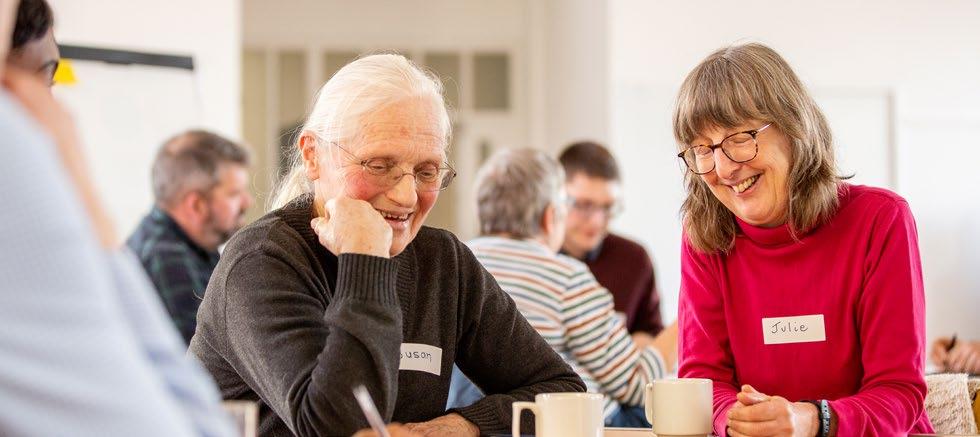
As part of the development of the guide, the Impact Investing Institute and Involve also organised a series of “Community Cuppas” - community engagement events in February 2023 in the North of Tyne region. The “Cuppas” were attended by members of local communities in North Tyneside, Newcastle, and Northumberland, representatives from
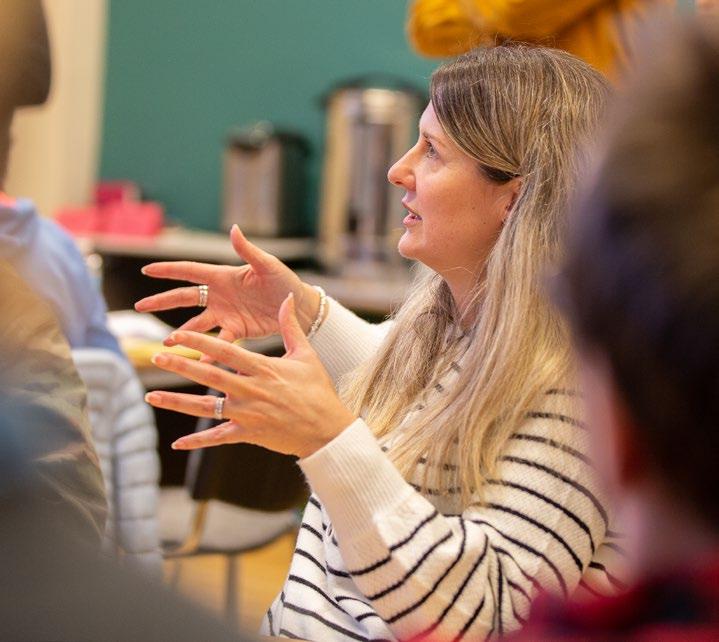
the North of Tyne Combined Authority, and local investors. The learnings from the Cuppas were used to make sure the content of this guide takes account of the preferences of a representative community for PBII. Key findings from the Cuppas are summarised in section 3.2.
The guide benefited from feedback from key stakeholders throughout August 2023. Thanks are due to all those who provided inputs and feedback and are listed in the acknowledgements section.
This section places community engagement in the broader context of place-based impact investing. The section also outlines the key motivations explaining why investors, and particularly place-based impact investors, seek to engage with communities.
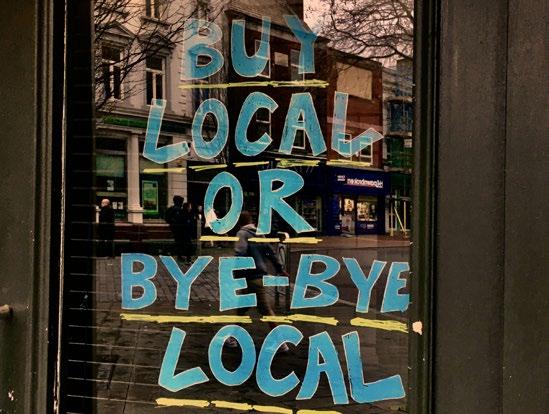

Place-based impact investments (PBII) are made with the intention to yield positive local impacts as well as appropriate risk-adjusted financial returns, with a focus on addressing the needs of specific places to enhance local economic resilience, prosperity and sustainable development. Typical sectors in scope for PBII include affordable and social housing, small and medium-enterprise (SME) finance, clean energy, infrastructure, regeneration and natural capital.
Place-based impact investments (PBII) are made with the intention to yield positive local impact as well as appropriate riskadjusted financial returns, with a focus on addressing the needs of specific places to enhance local economic resilience, prosperity, and sustainable development.
In the UK, PBII is a fast-growing field of impact investment. In 2021, the Impact Investing Institute, The Good Economy and Pensions for Purpose published a joint White Paper on Scaling up institutional investment for place-based impact. 2 The paper aimed to support a nascent investment area and advocate for the development of the right policy environment and practice to support its growth and subsequently, sustainable development in the UK. Since then, momentum has increased. The UK Government, in its Levelling Up White Paper, called on the Local Government Pension Scheme (LGPS) to invest 5% of its assets in projects that support local communities, noting it could unlock an additional £16bn of investment into the UK economy.3
A growing number of investment funds, many drawing on LGPS capital, now use a place-based lens. Examples of institutional funds that seek to invest using PBII include Legal & General, who committed to invest £4bn towards levelling up the UK’s towns and cities, and plans to invest £4bn into housing and regeneration in the West Midlands in partnership with the combined authority.4 The Schroders Capital Real Estate Impact Fund focuses on investing
in areas where residents experience above-average levels of deprivation and have the highest needs for housing, income, employment and health.5 The igloo Chrysalis Fund supports economic
growth and job creation by investing in development projects across Liverpool City Region, including improved offices, industrial units, warehousing, and distribution.6
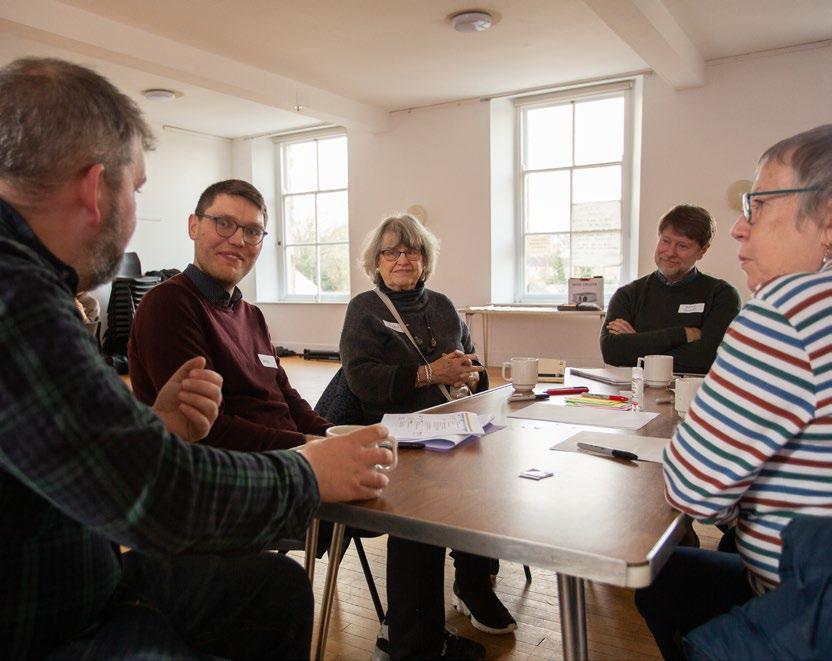
In line with the Good Governance Institute, we define a community as a group of people with a tangible or symbolic connecting structure – for example, location, job role, identity, or shared values.7 From a PBII perspective, shared ties to a location, or place, is an obvious defining feature, although this should not be seen to diminish the importance of other key community identities.
Community engagement is, in turn, a process that allows local people and organisations to play a role in shaping projects and decisions. Community engagement seeks to create a two-way dialogue that benefits both community members and the organisation(s) leading the engagement. In the context of PBII, we define community engagement as the process of engaging local people and communities in the development, decision-making and/or implementation of an investment strategy or project.
Community engagement is usually split into different types based on the level of participation that is expected from the community. The International Association for Public Participation’s (IAP2) Spectrum of Public Participation is a recognised global taxonomy for possible types of engagement and is organised around five public participation goals and associated promises to the public (see Figure 1).8
This guide follows this framework to demonstrate different approaches to
To provide the public with balanced and objective information to assist them in understanding the problem, alternatives, opportunities and/ or solutions.
Consult
Involve
Collaborate
Empower
To obtain public feedback on analysis, alternatives and/ or decisions.
To work directly with the public throughout the process to ensure that public concerns and aspirations are consistently understood and considered.
To partner with the public in each aspect of the decision including the development of alternatives and the identification of the preferred solution.
To place final decision making in the hands of the public.
We will keep you informed
We will keep you informed, listen to and acknowledge concerns and aspirations, and provide feedback on how public input influenced the decision.
We will work with you to ensure that your concerns and aspirations are directly reflected in the alternatives developed and provide feedback on how public input influenced the decision.
We will look to you for advice and innovation in formulating solutions and incorporate your advice and recommendations into the decisions to the maximum extent possible.
We will implement what you decide.
Community engagement is the process of engaging local people and communities in the development, decision-making and/ or implementation of an investment strategy or project.
community engagement activities. As this guide adopts a definition of community engagement as a two-way process, it focuses on practice linked to the ConsultInvolve-Collaborate-Empower public participation goals, rather than those contributing to the Inform goal.9 Focus on community engagement as a twoway process also means that the guide does not explore at length traditional approaches to community relations within corporate social responsibility (CSR), which might for example include staff volunteering and donations to charitable community funds, as well as instruments and tools such as community shares, which place the control of an asset directly into the hands of the community.
While PBII investors might be most familiar with community engagement that seeks to deliver on the Inform and Consult goals, some of their peers are deepening their community engagement further along the participation spectrum. Such approaches move beyond community engagement to empowering communities to have a stronger decisionmaking role in investment decisions and deliver deeper local impact.
Supporting the momentum towards deeper community engagement in PBII is the growing adoption of participatory approaches in philanthropy and the public sector. The rising use of participatory approaches in these adjacent fields has improved understanding of how these models can work in practice, and under what conditions they realise good outcomes. This expanding track record is also demonstrating that bringing in the perspective of people with lived experience leads to better and more informed decisions.10
In the field of philanthropy, there has been a marked shift towards bottomup approaches that give the ultimate beneficiaries more voice and agency over the distribution of philanthropic funds. In the UK, Camden Giving is a participatory grant maker with a mission to end local poverty and inequality in its local London area. The charity recruits panels of around fifteen local people,
who are not already engaged in decisionmaking, to award funding on issues relevant to their lived experience. Panel members are appointed for a limited time, paid for their time and are provided with training to support their decision making.
While community engagement by the public sector is commonly associated with traditional mechanisms for public participation (such as consultations), it has similarly witnessed the adoption of practices including participatory budgeting and participatory decision making. To date, almost a million people have participated in a local participatory budgeting process, globally and these processes taken together have allocated $350 million.11
In the UK, the North East Just Transition Fund (JTF), a £500 million ten-year commitment from the Scottish Government to support projects which contribute towards the region’s transition
to net zero, has given the community direct decision-making power over £4.2m.12
Working with the New Citizenship Project, Kirklees Council in West Yorkshire has used participatory approaches with an explicit place-based focus to generate tangible value. Since 2018, the council has undertaken 27 “Place Standard” conversations with almost 10,000 participants across 17 wards, involving at least two-thirds of the borough’s councillors. Budgets totalling £7.8m have been re-aligned to facilitate and support place-based working, and place-based engagement has influenced £7m of capital investment in small town centres. The council’s civic crowdfunding programme, Growing Great Places, has raised a total of £364,600 from almost 2000 backers for 37 successful local projects, with an 88% success rate. This represents a 2.5 times leverage rate on the council’s own pledges.13
PBII investors are finding that community engagement can improve both sides of the PBII equation, by driving better outcomes for people and places while improving financial performance. On the one hand, community engagement is central to the notion of PBII. If the ambition is to make a community’s experience better, then
the investor needs to have a clear line of sight to what the community thinks and feels about an investment. This is aligned with the preferences of communities, who would prefer and increasingly expect to be engaged in local decisions.14 On the other hand, investors who use PBII seek a financial return, which can also be enhanced through community engagement, through improved performance of assets and strategies and better risk management.
Investors should reap benefits through community engagement across the spectrum of public participation, however these are likely to be heightened through interventions linked to the deeper engagement part of the spectrum.
While this guide focuses on community engagement that typically goes beyond legal or regulatory requirements, investors and developers should be aware that requirements to inform or consult communities may exist at the national, regional or local level.18 In the UK, there are statutory requirements as part of the master planning process, while in other geographies there might be a requirement to engage with indigenous groups.
Specific benefits of community engagement in a PBII context include:
Building community trust is a key imperative for PBII investors. Trust facilitates the delivery of current and future local projects, and helps build a track record to facilitate development projects in other areas. At the same time, PBII investors are likely to be more visible to communities, as their investments might affect their homes, their landscape and their community. On the other hand,
In some geographies, there might also be an expectation that investors and developers enter voluntary agreements with community groups, such as so-called Community Benefits Agreements in the United States. Entering such agreements can be a strong signal of willingness to engage meaningfully with a community and might be a positive factor for securing opportunities from relevant local authorities.
failing to build trust can have a significant negative impact on the activities and operations of PBII investors in local communities, and hinder the achievement of expected outcomes.
Community engagement is increasingly relied upon by PBII investors as an effective way to build trust from affected communities. Research found that investors who engage regularly with communities, both formally and informally, experienced fewer negative perceptions about their activities.15


By giving communities a say – and in some cases a stake – in the decisions that will affect them, investors can build more positive relations and strengthen local partnerships.
Communities are likely to know their local context best. Community engagement can lead to a deeper insight into places, which in turn will help to identify positive impact, risks, and challenges at the local scale, and ensure investor priorities align with community goals. Engagement with communities can also help to identify partners and synergies with other initiatives, and to create and sustain a local ecosystem of positive impacts.
From an investor perspective, community engagement can provide valuable inputs into existing processes throughout the investment cycle. Experienced PBII investors often use community engagement jointly with desk-based research, including analysis of local needs data to drive investment decisions. Using both can help to verify, refine and if necessary, amend findings from each method to produce more accurate and actionable insights.
Community engagement can also augment processes used to assess, monitor and manage impact. On the latter, community engagement can be a
particularly useful means to ensure that the intended impact of investments has been achieved and is used by investors across asset classes.16
Community engagement can increase the long-term financial return of relevant investments. Research by the World Bank suggests that the benefits of community engagement ultimately outweigh its costs, for example by preventing negative long-term consequences.17 Adopting a place-based approach that includes meaningful community engagement can also contribute to asset performance (see box).
Legal & General Investment Management Real Assets (LGIM RA) own the Dolphin, a 680,000 square feet community and shopping destination in Poole, a coastal town in Southern England. The Dolphin comprises 90 shops, flexible working and community events spaces, an NHS outpatient assessment clinic, and a curated high street for local independents.
Over the past three years, the scheme has been transformed from a traditional shopping centre environment into a multi-use community centre, pivoting away from a focus purely on shopping and towards discovering, learning, working, and wellbeing.
LGIM RA’s first step in transforming the asset was to understand the needs of the local community via a combination of data analysis and community engagement. This formed the bedrock for the creation of a Community Partnership in September 2021, which has provided an ongoing framework for engagement between LGIM RA,
the Dolphin and local stakeholders including the council, charities, educational institutions, housing associations, and healthcare providers.
This community-driven impact approach to investment has brought holistic value by diversifying the use of asset and revenue streams, meeting local needs, identifying business opportunities, driving footfall and as a result delivering sustainable investor returns. Outcomes to date include:
• 2023 footfall (January to end July) being 11% up on 2022 and ahead of 2019 levels;
• Consumer spend in Q1 2023 being 7.8% ahead of Q1 2022 (benchmark schemes were -1.1%);
• Visitor dwell time was 98 minutes in Q1 2023, up from 90 minutes in Q1 2022;
• Spend per customer over the quarter increasing from £80 in Q1 2022 to £83 in Q1 2023 (+3%).
Investors should reap benefits through community engagement across the spectrum of public participation, however these are likely to be heightened through interventions linked to the deeper engagement part of the spectrum.
Community engagement is important for investor risk management, particularly in sectors that are associated with longterm impacts, including infrastructure and real estate. Failing to conduct appropriate community engagement can be corrosive
to the project and its execution.19 In particular, insufficient engagement can lead to conflict and backlash from the local community, delivery delays, harm to organisational reputation or negative direct costs (for example from litigation or adaptation).
Figure 2 captures two approaches to community relations based on whether they incorporate community engagement. The decide-announcedefend approach, which does not include community engagement, can seem quicker and simpler. However, this approach increases the likelihood
of generating conflict. Defending the solutions against opponents delays implementation, is time consuming and requires resources. The engagedeliberate-decide approach, which entails community engagement, allows objections and doubts to be untangled and worked through proactively.
One often-cited example is the Fosen Vind wind park in Norway. As local indigenous Sami communities and other key stakeholders were insufficiently engaged before construction, it later became apparent that the wind park disrupted traditional reindeer grazing patterns. Legal proceedings ensued and
culminated in the Norwegian Supreme Court deeming the wind park illegal. The wind farm continues to attract criticism, including by prominent environmental campaigners, and years of ongoing protest, resulting in disruption of business activities.20
Emerging evidence suggests that meaningful community engagement can help to mitigate the risk of projects being derailed by voices systematically opposed to the development of new infrastructure, commonly referred to as NIMBY (“Not in my back yard”).23
For example, the Sleaford Community Power Fund was set up as a partnership between Schroders Greencoat and the North Kesteven District Council to support community projects and organisations within a five-mile radius of the Sleaford Renewable Energy Plant (REP) in Lincolnshire, England, which is owned by Schroders Greencoat. Border to Coast, a local government pension pool, is also invested in the plant as a minority shareholder.24
The management of the fund itself represents a good example of community engagement. North Kesteven District Council administers the Fund with the aim to distribute £125,000 over five years. A panel made up of local community representatives, local councillors and representatives of Sleaford REP meets quarterly to assess the applications for community funding.
In addition to the Sleaford Community Power Fund, Sleaford REP has funded several community schemes, such as apprenticeships. and provides free heating to public buildings in Sleaford town centre saving the council approximately £100k per year.
In an increasingly sophisticated and competitive PBII market, strong credentials in community engagement can provide an opportunity for differentiation for asset managers seeking to secure commercial opportunities. Evidence of engagement with communities is becoming increasingly expected by asset owners and other clients of PBII investors, who are therefore encouraged to differentiate themselves by developing or furthering their community engagement approach.
In the UK, evidence of community engagement can also help strengthen social value scores, which will improve the chances of procurement awards from local authorities.21
The Just Transition Finance Challenge convened by the Impact Investing Institute brings together 22 financial institutions – asset owners and asset managers, including leading PBII investors – controlling over £4 trillion in assets who are committed to invest for a fair and inclusive transition to a low carbon economy. The Challenge’s framework for just transition finance is articulated around three elements: i) climate and environmental action; ii) socio-economic distribution and equity; and, notably, iii) community voice. The inclusion of the latter element reflects growing interest in this theme by different types of investors.

Community engagement is important for investor risk management, particularly in sectors that are associated with long-term impacts, including infrastructure and real estate.
This section lays out the main considerations for investors seeking to do community engagement, through a step-bystep guide to community engagement, insights into specific community engagement methods and a list of common pitfalls to avoid.

Investors have different starting points when it comes to community engagement. Most investors do not yet do extensive community engagement and might not know where to begin. Others might be already doing community engagement but wish to enhance their approach, so it is as effective as possible.

This section aims to support investors in doing community engagement.
It is structured as a series of questions, captured in Figure 4, that investors can answer in turn to do community engagement in a way that is adapted to their circumstances and needs.
For ease of reference, Appendix I captures the insights from this section in the form of a checklist.
What does good community engagement look like?
What role should the investor play in community engagement?
In going through these above steps, investors will find it beneficial to reflect on who has a say in successive decisions. Lived experience of the places and communities to be engaged can add real value, and some investors have accordingly developed their community engagement approach in partnership with the communities to be engaged.
What is the purpose of the engagement?
What is the public participation goal of the engagement?
What is the scale of the engagement?
What outcomes and outputs should the engagement produce?
What are the timescales for the engagement?
What information already exists?
What resources are available?
How will success be measured?
Through intermediaries (e.g., by engaging the fund manager or management of an investee or asset)
At a minimum, investors should ensure that diversity, equity and inclusion (DEI) considerations are reflected in the development and implementation of their community engagement, for example by ensuring that a diverse set of stakeholders are involved in the planning and delivery of the engagement. On DEI aspects, and in doing community engagement approach more generally, investors can seek specialised support from the organisations listed in Appendix II.
Who should be engaged?
Who can be a suitable partner?
Which method(s) should be used?
How should investors communicate with the community engaged?
Sustaining community engagement
How can investors embed community engagement in their activities?
How can investors communicate externally about their community engagement?
Figure 4: Step-by-step guide to doing community engagement.While there is no “one-size-fits-all” approach that will guarantee effective community engagement in all situations, there are a number of characteristics that are often cited in the literature and by practitioners as conducive to meaningful community engagement:26
• Appropriateness: Investors should ensure that their community engagement approach is appropriate for their investment strategies. There should be appropriate resourcing and guardrails to mitigate circumstances, internal or external, that might be detrimental to community engagement in the long-term.
• Continuity: To reap its full benefits, investors should do community engagement as an ongoing process throughout different stages of the investment cycle, rather than as a one-off or series of engagement events. Successful community engagement often builds on continued interaction, particularly for projects that have a longer time horizon.
• Additionality: Prior to conducting community engagement, investors should familiarise themselves with what is already known about a place and the needs and preferences of local communities. Where possible, investors should avoid repeating engagement efforts with a community, unless there are compelling reasons to do so. Investors should avoid doing community engagement when there is no clear identified purpose or outcome, to avoid contributing to consultation fatigue.
• Collaboration: Investors should collaborate not only with communities themselves but also with relevant local actors, including local authorities and community organisations. Where possible, investors should collaborate with their peers who invested in local places to avoid duplication and maximise community outcomes.

• Inclusion: PBII should be inclusive when engaging with communities, by taking steps to effectively identify and involve a diversity of local people and perspectives. Investors should take particular care to identify barriers to engagement and ensure that they have implemented mechanisms to remedy them, increase accessibility and engage a diverse and representative set of voices.
• Reciprocity: PBII investors should see community engagement as a two-way process, which provides the opportunity to build mutually beneficial relationships. Investors should build and maintain effective feedback loops with communities. Where appropriate, PBII investors should also empower communities over time, for example by helping to build local capacity and providing opportunities for communities to have a greater say on decisions that will affect them.
• Transparency: PBII investors should, to the extent possible, be transparent about their activities that might impact a community, in particular around the terms of their engagement, for example what can and what cannot be changed as a result of engagement.
• Accountability: PBII investors should put in place appropriate accountability mechanisms to ensure they deliver on their commitments. Investors should also embed community engagement into their processes, for example regarding environmental, social and governance (ESG) integration and impact management, monitoring and reporting (IMMR). Investors doing community engagement should remain open to being challenged on any aspect of their activities that affect the community.
The first step in doing community engagement is to establish the role the investor will play. Investors may choose to take a direct or indirect role in community engagement, ranging from leading the engagement to influencing and assuring engagement through intermediaries, such as a fund manager or the management company of an investee or asset.
Investors may choose to engage communities directly, alone or in partnership with others. This is wellsuited to situations where community engagement is expected to inform an investment strategy or a specific investment for which the investor is responsible or has significant control.
Typical examples include real estate development projects or private equity investments that the investor owns or in which it has a majority position. Direct engagement by the investor might also be appropriate when significant stakeholders – such as the local authority or community members themselves –
have expressed their preference for the investor to lead the engagement, or do not have the resources to do so themselves.
Rather than delivering community engagement directly, some investors choose to take an influencing, or stewardship, role in community engagement. In such a role, even if the direct relations with communities have been “outsourced”, the investor aims to ensure that the relevant intermediaries are doing appropriate community engagement and, where
necessary, influence them towards better community engagement practices.
This model will be the most familiar to investors in different asset classes. In the context of PBII, it is typically used when the investor has limited control over an investment, for example in a public equity investment or a private equity minority position. It might also apply best in the case of an asset owner investing in a PBII fund, or in the case of a fund manager engaging with its investee companies or assets of which it has outsourced management.
The best role for the investor to adopt will depend on factors such as: the purpose and goal of the engagement, the type of asset, its business model, the type of investor (for example, asset owner or asset manager), whether the investor is responsible for decision-making, the skills and capacity of the investor in community engagement and whose engagement is sought.
While there are clear benefits to investors doing community engagement in many cases, investors should remain aware that there are instances where engagement with communities, and particularly direct engagement, might not be appropriate and, in some cases, can lead to negative effects that outweigh benefits.27
Investors seeking to do community engagement are in particular invited
to conduct a preliminary analysis of the power dynamics of a prospective arrangement to ensure power imbalances are not excessive.28
Caution should be exercised by investors developing strategies that might impact vulnerable groups (for example social housing tenants, people with disabilities or persons fleeing abuse). Engaging with such groups will likely require specialised skills,
such as the use of a trauma-informed approach and the curation of physically, psychologically and socially safe spaces for the engagement.
In such cases, it is highly advisable for investors to seek specialised support from community organisations such as those listed in Appendix II and reconsider their engagement approach accordingly, including by considering engagement through experienced intermediaries.
Investors may choose to adopt a more or less direct role in community engagement throughout their portfolios. For example, they might deliver engagement directly themselves to establish PBII strategies and choose sectors for investments, while they indirectly maintain the community engagement integrity of their underlying investments through stewardship and assurance.

Indirect engagement does not mean that the investor should remain passive. The investor will often be able to steer the relevant intermediary to enhance its approach to community engagement. For example, an asset owner partnering
with an asset manager to develop a bespoke PBII solution aiming to invest in its local area can request community engagement to be at the core of the manager’s approach. Similarly, an asset manager taking a majority or significant stake in an investee company or asset is likely to have the opportunity to influence the investee’s approach to community engagement.
Even in instances where general community engagement is outsourced to the management company of the asset, it may be appropriate for the investor to organise occasional community engagement events, so they hear community views first hand as part of their IMMR and due diligence processes.
In other situations, there might be more limited opportunities to influence community engagement practices by the intermediaries, so the investor might feel comfortable with the assurance that a minimum threshold of community engagement (for example expressed in contractual agreements) is met. This would include investment in a larger PBII fund without significant control, or a minority stake in a company or asset. Such approaches can remain impactful. For example, investors investing in real estate projects can ensure that developers maintain good community engagement beyond the initial realisation of the project.
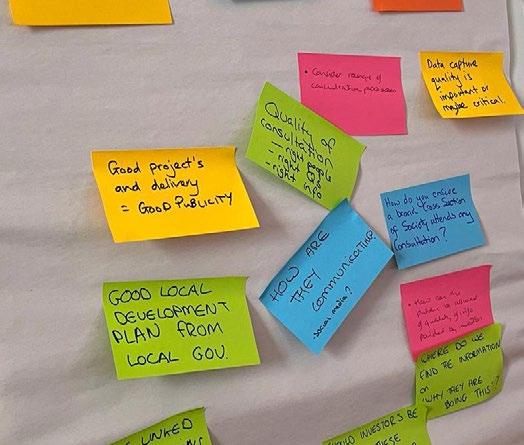
Indirect engagement does not mean that the investor should remain passive.
The following steps in the process are primarily targeted at investors seeking to assume a direct role in community engagement. Investors taking on an indirect engagement role can refer to the specific guidance in section 3.5

The next step should be to establish the purpose it will serve. The investor should establish why they are seeking community input and, accordingly, into which part(s) of their investment cycle the engagement will feed.
The specific purposes for which investors might seek to engage communities include:
The most open-ended purpose for community engagement is engagement that will inform the development of a place-based impact strategy at an early stage of the investment cycle. The purpose of such engagement is to identify impact priorities at a local level, to in turn feed into the design of this strategy. Investors typically do this to ensure that investment priorities are in tune with the aspirations, preferences and needs of local people.
For example, a local authority pension fund seeking to invest in line with the Levelling Up White Paper’s 5% local allocation target could engage communities to inform what to prioritise in these investments. To do so, it could consult with stakeholders from local anchor institutions and a community panel to shape the development of its investment strategy.
Community engagement can be sought to inform decision-making in situations where the investor has established a broad investment strategy, for example affordable housing or small and mediumsized enterprises (SME) finance, but is looking to ensure its approach to these investments will be most relevant to local needs and priorities.
For example, an investment fund focused on SME finance could engage local organisations to explore the issues faced by local businesses to identify ways it could help generate demand through its investments.29
Community engagement is often done with the ambition to inform the planning, development, implementation or decommissioning of a specific investment, project, or asset. The depth and intensity of engagement will depend on several factors, such as the stage of
development, how large a project it is, and the impact it is likely to have.
While not every investment will require extensive community engagement, it will be particularly recommended for projects with a material impact on the community members’ lives. In such cases, PBII investors may seek to gain confidence that the investment will have positive benefits locally, and that any potential negative impacts are understood and effectively mitigated.
For example, an investor looking to develop new housing infrastructure could engage with local residents to understand what concerns and needs they have in regard to the proposed projects, and what possible community infrastructure benefits could be proposed to them as part of the development process to address these.
For funds that target deeper community engagement, community engagement on specific investment decisions and deal terms might be appropriate. A community-led fund seeking to fund local businesses might engage community members to understand what investment terms will be most appropriate, for example in terms of payback period and risk and return profiles. Similarly, a fund might involve community members on investment committees who will make the final investment decisions.
Insights from local communities can be a precious input to measure and review performance, from strategy level down to specific investments, over time. Communities can share on-the-ground experiences of the impact investments are and are not having, and what could be done to improve performance.

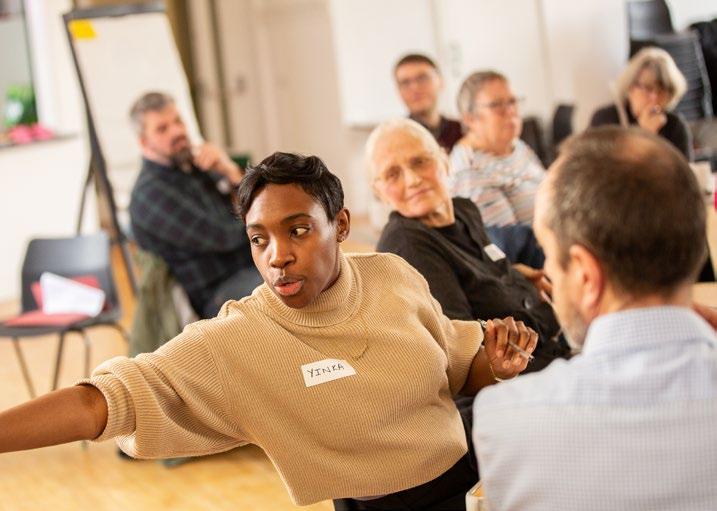
For example, an investor in a renewable energy facility might seek to engage with communities to ensure that the facility’s operations are not having unexpected negative impacts on the communities to surface potential causes of backlash. The engagement can similarly serve to monitor that agreed community benefits are being delivered. Such engagement can be repeated to understand evolution over time: in the above example, the investor could convene a representative community group annually to give their perspective on the ongoing impacts of the facility.
In addition to that, investors should check with their target audience whether their community engagement approach is working or not. This might help to surface the community’s perception of the quality of the investor’s engagement efforts.
example in terms of payback period and risk
A community-led fund seeking to fund local businesses might engage community members to understand what investment terms will be most appropriate, for
and return profiles.
The Community Cuppas were three community engagement events that brought together over 50 residents in the North of Tyne area (Hexham, Newcastle and North Shields). The findings of the Cuppas provide insights into community preferences regarding engagement. Participants were specifically asked for their views on when community engagement should happen in place-based impact investing and who should be involved, through a series of sessions jointly facilitated by Involve and the Impact Investing Institute.
Overall, participants felt that:
• Community engagement should happen at different stages of an investment: before deciding what to invest in, before detailed plans are drawn up and once detailed plans are in place. This allows investors to identify community wishes and needs early on, and continue to get feedback from the community as plans develop.
• Investors should first do their research to see what engagement outputs already exist and what similar processes have taken place in the area. This may mean speaking
with the local authority, community and voluntary organisations, and other investors. Community members commit and invest time and energy to take part in an engagement process so processes should not be duplicated to avoid frustration and consultation fatigue and save the investor time and resource.
• The design of an engagement process should be context dependent and take into consideration what investors are asking community members, the place where the investment is being made, and who is being reached. Investors should utilise different recruitment methods, online and offline, that are appropriate to their context.
• Community engagement is not always accessible to everyone. Participants called on investors to make the effort to hear from those who would not usually put themselves forward in self-selecting methods, for example because of lack of digital literacy or lack of confidence to engage, or due to being a member of a less-heard group.
• Investors should make sure to engage with a diverse representation of local people – for example through a mini public or a broad selection –alongside specific groups who are differently or particularly affected. Participants noted that diverse representation gives investors an idea of what the majority thinks and provides an honest picture of a wide range of views. Participants noted that specific groups offer specialist knowledge, and those most affected by decisions should have their say.
The Community Cuppas were three community engagement events that brought together over 50 residents in the North of Tyne area (Hexham, Newcastle and North Shields). The findings of the Cuppas provide insights
While desk-based research and community engagement are often understood as separate inputs into decisions, there are practices that give community members a driving role in research on places. For example, Prosperity in east London (Piel) 2021-2031 is a 10year study tracking the prosperity of over 4,000 households in 15 areas of east London where large-scale and long-term urban regeneration is driving rapid physical, economic, and social changes in local communities.30
Piel uses a mixed methods approach that combines household surveys with qualitative research undertaken by citizen social scientists - local residents employed and trained by University College London’s Citizen Science Academy to work as social scientists in their neighbourhoods. Among other benefits, this approach offers a hyper-local look at who benefits and how from regeneration investments, while building local skills and capacities.
into community preferences regarding engagement.
The next consideration in the process should be to establish what is the public participation goal that the investor aims to achieve. In other words, what is the impact that the community engagement will have?
Typical public participation goals in a PBII context include:
Description The investor seeks to inform the relevant communities of their investment activities in the local area.
The investor seeks to directly gather the feedback of communities on specific plans or decisions.
The investor works directly with communities from an early stage, with a promise that concerns and aspirations will be directly reflected in ultimate decisions, with a clear feedback loop.
Promise to the community
We will keep you informed. We will keep you informed, listen to and acknowledge concerns and aspirations, and provide feedback on how community input influenced the decision.
We will work with you to ensure that your concerns and aspirations are directly reflected in the alternatives developed and provide feedback on how community input influenced the decision.
The investor works extensively with communities in all aspects of the decision, through a co-creation process that includes co-design and co-production.
The investor supports local communities in the development of funds that are communityled, with decisionmaking power lying with community members.
We will look to you for advice and innovation in formulating solutions and incorporate your advice and recommendations into the decisions to the maximum extent possible.
We will implement what you decide.
Figure 5: Spectrum of public participation in the context of PBII. Public Participation Goal Inform Consult Involve Collaborate EmpowerExample A real estate investor provides information, for example by organising a pop-up kiosk regarding an upcoming development in the local area.
A manager of an SMEfocused fund raises awareness of financing opportunities available to local businesses.
A manager of a PBII fund seeking to invest in an area seeks feedback on its proposed priorities for investment from the local community.
A real estate investor seeks to gather views from local residents on proposed redevelopment plans in their neighbourhood.
In both cases, the managers create opportunities for feedback on more than one option, and should come with a commitment to conscientious consideration, and a defined feedback loop as to how feedback has influenced decision making.
Case study (see section 4.1)
Schroders Capital Real Estate Impact Fund (UK)
Astarte/Yoo CapitalShepherd’s Bush Market
A renewable energy investor launches a community investment fund, which is capitalised with an existing percentage of the revenues of a local facility.
Through a series of workshops, the investor identifies the investment strategy and priorities for this fund prior to its launch.
An SME fund manager actively collaborates with community representatives. The fund uses inputs from the community on the designing of the fund strategy and convenes a community advisory community to provide strategic steering and input into investment decisions.
The community itself drives the development of its own investment activities. Such funds typically aim to embed community engagement within the design of the fund, starting from the investment strategy stage to allocation decisions and performance measurement and review. The fund manager has agreed in advance to do what the community decides, acting as a supporter, advisor and implementer throughout the lifecycle of the fund.
Gresham House – North Ayrshire forestry Resonance Community Developers
The Ujima Fund
Barking and Dagenham Giving The REAL People’s Fund
Clarifying the public participation goal at an early stage will contribute to the success of the engagement. It will help guide the investor in determining how the input received will be used after the engagement and ensure this remains consistent with the initial purpose. Clarity on the goal will help the investor to express what they need to ask the community and on what feedback is wanted. This, in turn, will also ensure expectations remain aligned between the investor and the community engaged.
The next step is to establish the right scale for the engagement. The primary consideration in setting the scale of the engagement should be that it is commensurate with its intended purpose and public participation goal, as well as the type and size of investment.
For example, the construction of a renewable energy facility is likely to require larger-scale community engagement than the building of a small number of houses. Similarly, a fund manager who incorporates community views in its investment decisions should develop a more extensive and sustained engagement process than a peer who is looking to identify an investment in an area as a one-off exercise, or to conduct
a periodic assessment of the local impact of an asset.
It is advisable to think through the outcomes and concrete outputs that are intended to come out of the engagement process as part of its planning.
Within the defined purpose and public participation goal, the outcome refers to the difference that the process intends to achieve, its overall results and impacts – in other words, it is a statement of exactly what is sought from community engagement.
In a PBII context, possible engagement outcomes would include the identification of local issues; opportunities and challenges to guide investment decisions; the generation of new ideas for investment; agreement on direction of an investment strategy or project; or feedback on community impact of an asset. They can also include building support for a planned project, and identification of community partnerships. Secondary outcomes can also be identified at this stage, for example better links and trust between the investor and the community that comes from engagement exercises.
Outputs are the tangible products of the process. For example, is the investor looking to compile a focused set of community requirements, preferences, principles, or criteria that should be applied in investments? Is the aim to collect broader insights to provide additional context for the analysis of place-based needs? An example of a community engagement output, based on the Community Cuppas, is available in section 3.2.
Establishing the expected outcomes and outputs from the start will greatly
facilitate the incorporation of the findings from community engagement and ensuring it fulfils the planned purpose of the engagement.
In planning community engagement, investors should identify the timescales available, as different ways of doing community engagement will demand various amounts of time depending on

the purpose and scale of the engagement and methods used. Investors should ensure that adequate time is allocated to research, event planning, production of materials for an engagement process, and delivery. Feeding back the findings of the community engagement process can be a time-intensive process, particularly where the engagement has delivered results different from those that were initially expected.
Prior to starting community engagement, investors can save significant time and resources by building on information that is already available about local needs and concerns, for example as part of local authority planning documents. Engagement done by other organisations can also provide a starting point for the design of new engagement.

Beyond efficiency gains, doing such research will help investors to better adapt their engagement to the local context. To the extent possible, investors are encouraged to enquire locally which methods have and haven’t worked well in the past and balance these insights with their own objectives and constraints (including budget constraints). Mapping what local engagement mechanisms are already in place and which organisations
hold trusted relationships with various parts of the community will also help identify potential partners for the engagement.
Available resources, both in terms of budget and internal capacity, are another important consideration in planning community engagement. While recognising these constraints, investors should, where possible, aim to adapt their resources to the needed community engagement, rather than the other way around.
It may also be beneficial for investors to collaborate with external organisations who might bring in additional resourcing (see Appendix II for a list of specialist organisations who can provide support).
As a final step in planning community engagement, it is advised to establish upfront how the success of the community engagement will be measured. While key performance indicators (KPIs) will vary for each engagement, the following qualitative and quantitative metrics can provide a starting point:
• Number of community members engaged and number of engagement events;
• Percentage of engagement participants who provided positive feedback on the engagement;
• Percentage of community members engaged who have a minority and/or disadvantaged background;
• Completion and achievement of intended outputs;
• Quality and actionability of community engagement outputs and outcomes;
• Number and percentage of decisions that were influenced by community engagement;
• Achievement of expected timescales;
• Percentage of community members on investment panels;
• Number of decisions taken by community advisory panel;
• Amount and percentage of investment managed by community invested in minority-led businesses.
From an accountability perspective, it is good practice for investors to use selected KPIs to regularly assess, review and where necessary update their approach to community engagement.
Investors doing their community engagement through intermediaries should also regularly review whether these are delivering the intended community engagement.
Determining who is part of the community to be engaged is a key decision to be made. The group to be engaged should be identified based on what the investor aims to find out as well as the sector and type of investment. For example, a regeneration project in a town centre will impact local businesses, residents and the wider community who use the amenities. The development of a
major renewable energy project will impact the immediate local community, the wider community that might benefit from increased electricity generation, and impact local jobs and supply chains. Investors should pay careful consideration and work with a place to identify and engage all stakeholder groups that might be impacted by the project.
investments. Communication and engagement at the local level are incorporated into the investment process for a large portion of investments. This unique governance arrangement enables SYPA to maintain close engagement with its membership and interested organisations locally.31
There is no “right” size for the number of community members to be engaged and more community members being engaged does not necessarily mean better community engagement. If the purpose of the community engagement is relatively narrow and resourcing limited, it might be appropriate to engage a small group of community representatives (e.g. local organisations). Broader engagement questions and more resources might invite engagement with bigger groups or the constitution of representative samples, which might require specialist support.
It is good practice from an inclusion perspective to consider ways to enable participation from a wide range of community members beyond those who usually respond to calls to share their views, notably by using methods that go beyond self-selecting groups. This could range from drawing together a group that is representative of the make-up of the community (using the process of sortition, as is done in a citizens’ assembly) or engaging through local organisations to getting communities to deliver community engagement themselves (e.g. through a distributed dialogue process).
It is also good practice to reach out to communities that may be differently impacted by the proposed investment and those usually underrepresented in local democratic processes. Investors should pay particular attention to people who are typically ignored, as those who might be the most impacted (positively and negatively) by a decision. Collaboration with trusted organisations and community leaders for outreach can be very effective in such situations.
It is often appropriate to support people to take part by offering a financial compensation, covering costs such as childcare, and doing engagement at a time of the day that makes it easy to attend.32 Other accessibility features such as hearing loops, step-free access, the provision of interpreters, and the translation of recruitment materials into different languages spoken in the community can also be helpful to increase inclusion in community engagement. The use of digital engagement methods offers both opportunities and challenges from an accessibility perspective (see page 36).
Investors often do community engagement in partnership with other organisations, such as the local authority, community groups, other actors of the local ‘ecosystem’ or a third-party specialist engagement provider. In such situations, the investor typically works with these organisations to develop, implement and/or report on a community engagement approach.
Joint engagement with partners can bring a host of benefits depending on the nature of the partnering organisations:
• Working with a local community organisation can deliver a richer understanding of local needs and meaningful engagement to help address the perception of superficial consultation or consultation fatigue. They can also help to identify key groups to be engaged in the process who might otherwise be missed.33
• Working with a local authority can help ensure better coordination with public actors and give both partners confidence that the project for which community engagement is sought is aligned with local priorities, as reflected in Local Plans, master planning, and other planning documents that are a statutory requirement - see box below.
• Working with an organisation specialising in community engagement can bring in additional resources and expertise. Facilitation by a third party that is seen as independent can further help to build trust with the communities engaged.
To find suitable partners, it is advisable to research and engage with local impact investing and/or community organisations and networks - such as the local authority, civil society organisations, universities, and business groups who can help provide an initial mapping of suitable partners as well as associated opportunities and risks. When working in partnership, it is advisable to decide on the roles and responsibilities of each organisation involved to ensure smooth ways of working and clear lines of accountability.
Compensation expected by different types of partners will vary. Organisations specialising in community engagement are likely to charge a fee for their services, while local authorities are not. Local community organisations and networks should be compensated at a fair rate according to the services delivered, unless they have expressed a preference to the contrary.
Working in partnership with local authorities is often a win-win arrangement for all parties. Such partnerships can support the delivery of projects based on comprehensive community engagement that are backed both by public and private actors.
In the UK, the process of local master planning provides a useful framework for collaboration between local authorities and PBII investors. All local authorities are required to have an upto-date Local Plan, which sets out an overall vision for future development of a place. For specific developments there is a statutory requirement to create a master plan which engages the local community and stakeholders. Investors and developers can partner with local authorities to deliver community engagement for this, while local authorities can remain in the driving seat by coordinating engagement efforts and make their outputs widely available.
For example, in 2023, the Innovation District Manchester Partnership – a joint venture between Legal & General, University of Manchester
and Bruntwood SciTech, announced a consultation period for their ‘Strategic Regeneration Framework’ which included community events and online feedback channels, with all findings being reported back to the investors and Manchester City Council.34
Partnering with local authorities leverages the respective strengths of public and private actors. In the context of social and affordable housing strategies, for example, it might not be fruitful for an investor to conduct engagement to understand local needs on housing. Engagement on issues such as mixing tenants (social/ affordable/shared ownership) and unit types (e.g. homes for families or individuals, houses or apartments) will benefit from the democratic legitimacy of a local authority. On the other hand, the registered provider that operates these assets can conduct community engagement with residents to surface day-to-day issues, opportunities for improvement and, in some cases, support services such as for example help with financial management to prevent indebtedness or courses to improve employment opportunities.
There is a range of methods available to do community engagement. The right method should be identified according to key elements of the community engagement that were previously set, including its purpose, public participation goal, expected outcomes and outputs, timescales, target community, and in light of available information and the resources of the investor and their partners.
Clear answers to these questions will help inform which method will be most relevant to deliver the community engagement. Methods can be combined and adapted depending on the context of each investment.
The methods below are classified according to the public participation goal that they are most commonly used to achieve. This is not a comprehensive list;
additional methods can be found on the Involve website and Participedia, a global database for researchers, activists, practitioners, and anyone interested in public participation and democratic innovations.35
The next section gives an indicative idea of different methods based on costings, using a not-for-profit consultancy for support, design, and delivery. The cost, timings and staffing need for different methods are dependent on the specifics of the community engagement and project, and what external expertise will be sourced.
While they might require more resourcing, more ambitious methods are generally deemed as more robust and rigorous, and might be worth the additional expense given the legitimacy they provide.
However, more expensive or costly methods are not necessarily better and the specific circumstances of each engagement should remain the primary driver of selection.
While they might require more resourcing, more ambitious methods are generally deemed as more robust and rigorous, and might be worth the additional expense given the legitimacy they provide.
A facilitator leads a guided discussion of 8-12 people to gauge their views and attitudes on the subject on which the investor aims to engage the community. Focus groups provide useful information on how people respond to questions or issues, and the researcher takes notes. The participants are not expected to reach a common conclusion.
Pop up stalls are a temporary form of engagement located around the community, for example outside of a supermarket, at sporting events or at local markets. The stalls might ask people to add comments about what they do or do not like about their local high street.
Feedback kiosks are electronically operated touch screen devices
which can be placed in any space. They are often seen in public spaces such as hospital waiting rooms and ask people’s opinions without them having to be staffed. These methods allow to engage people where they are. The information provided can then be analysed and fed into other processes as evidence.
Community conversations are conversations facilitated within groups of
community members. An investor can engage with these groups in their own space, to give them greater freedom to express themselves in a safe environment, free from potential harms in a broader group setting.
A community panel convenes a group of up to around 25 people representing local community groups and specific actors with an interest in the investment who would not otherwise be heard. The panel can be convened as a one-off or as an ongoing engagement structure, and might be granted a formal advisory role.
Crowdsourcing is the practice of obtaining services, ideas, functions, or contacts from a large and undefined network of people. Crowdsourcing is a predominantly online practice, although it can be carried out offline. While often used towards a Consult goal, crowdsourcing also offers an opportunity to fulfil deeper public participation goals with relatively low barriers.
Conversation cafés are a trade-marked process for running informal, hosted, drop-in discussions in a café style setting. The process assembles small number of people, usually up to 10 people, plus the host, and a time is given for discussions. The host gives the people at the table one or more questions for them to discuss. Participants have the chance to share their views in order, followed by dialogue and a reflection at the end. Conversation cafes usually last 1-2 hours.
Deliberative workshops are small-scale workshops where the focus is on having in-depth informed discussion on a topic to reach a shared conclusion. A facilitator will usually work with no more than 8-12 people in a single group, although multiple group discussions can take place simultaneously.
Mini publics bring together a group of people who closely reflect the local population in terms of demographics (such as age, gender, ethnicity, and social class) and sometimes relevant attitudes. Together these people discuss an issue and reach a conclusion about what they think should happen. Mini publics tend to follow a three-step process where members:
1. learn about the issue;
2. deliberate it with one another weighing up different potential conclusions;
3. and decision-making where they agree a way forward.
Mini publics can range in time and depth. Citizens’ assemblies will involve around 100 members who are brought together to explore an issue over multiple days and meetings. A citizens’ jury is generally composed of a smaller group of people - around 12-24 community members – over a shorter amount of time. A public forum can be held where the jurors present their findings and recommendations and explain how they reached their decision.
Technology brings together 500-5000 people, combining small scale discussion with group decision making. The participants are split up into groups of 10-12 people, where they have facilitated small-group discussions. Each facilitator uses a networked computer to instantly collate ideas and votes from the table. This information is sent to a central point where a team summarises comments from all tables into themes that can be presented back to the room for comment or votes. The whole process can either take place within one room, or groups can gather in many locations around the country or globally.
A distributed dialogue sees the commissioner of the engagement creating an event design pack, which is given to different groups for them to run it themselves. The engagement is centrally planned, and dialogue events are self-organised by participants, with the aim of engaging a wide range of communities and organisations. The groups or individuals organising dialogues enjoy a high degree of autonomy over who is involved.
Co-creation
Co-creation methodologies enable active participation by community members as designers and implementors. In practice, it means that those who are affected by a decision are not only consulted, but are part of the conception, design, steering, and/or management of the fund or asset. This can be a highly effective approach, but it is resource intensive as it is often essential to support the participants and professionals throughout the exercise to ensure that they are able to contribute on an equal footing, for example by providing information, training, mentoring.
Participatory futures encompass a range of approaches for involving the community in exploring or shaping potential futures. For example, a series of workshops might bring together a diverse group of community members to consider the possible implications of interventions (for example impact of just transition plans) to understand the possible implications for jobs, the community and the natural environment and discuss priority areas for action. These approaches aim to democratise and encourage long-term thinking, encourage public imagination about how the future could be, and translate images of the future into collective actions and behaviours in the present.
Participatory budgeting involves community members directly in making decisions about budget issues. This can take place on a small scale at the service or neighbourhood level, or it can be done at a city, regional or national level. In practice, the power
delegated to the community members in the decision processes varies, from providing decision-makers with community preferences to processes that place parts of the budget under direct community control.
It can be run as a one-off process, but long-term benefits such as social capital and ownership, require a recurring, cyclical process. Participatory budgeting can deliver increased transparency and establish the legitimacy of budget decisions. It has also been shown to build the skills and awareness of participants through the process of deliberation.
Similar to participatory budgeting, participatory policymaking seeks to hand community members influence and control over different aspects of decision-making. In an investment context, participatory approaches may be used to give community members decision-making power on the development of investments policies and strategies, as well as on specific investments.
Community members can be directly represented in relevant decision-making bodies of investment funds. These might include committees responsible for setting investment priorities, investment committees, and impact assessment committees. Another model is to have communities represented through a specific mechanism, such as a community panel, that has a decision-making role. While the potential in terms of community engagement is significant, community members might also require support in order to effectively fulfil their tasks.
Newham Council, in partnership with the Royal Docks Team - a multidisciplinary local government team that works in partnership with local community groups, developers, and local businesses - is running a largescale project to improve the Royal Docks Corridor in London. The project aims to create 60,000 new jobs and 25,500 new homes in the wider area, provide general uplift by creating public spaces, wider pavements, cycle lanes,
better connections to local destinations, while improving air quality and delivering more green spaces.36


Given the complexity and scale of the project, community engagement with residents and businesses was done through different channels, demonstrating the benefits of a mixed methods approach. Methods included online engagement consisting of surveys and a Q&A forum and printed publications to increase accessibility.
The survey received 185 responses that also included up to 572 detailed free-text comments. Paper leaflets were provided that included background information and a plan of the project area. Direct engagement consisted of four sessions held for local residents to discuss proposals, provide comments and ask questions, two of which were held online. Analysis showed that overall, the scheme was strongly supported by the local public.

Technology-enabled tools have been gaining in popularity to support and deepen community engagement.
Examples include:
60 Decibels is a tech-powered impact measurement consultancy that helps organisations to maximise and collect impact data through community and end-user engagement. 60 Decibels works with corporations, investors, funders, NGOs and social enterprises globally. To gather impact data, 60 Decibels research assistants speak to impacted communities, by phone and in the local language. 60 Decibels then produces short, standardized surveys built for repetition and comparability, including with industry peers.
Built-ID is a B Corp, community-centric software company that aims to support decision makers in including diverse voices in change-making processes. It does this through an award-winning digital community and engagement platform, Give My View. The platform supplies digital tools including interactive surveys, working with the client to design tailored approaches based on specific communities and projects. Built-ID has worked with UK councils including Flintshire and Milton
Keynes, as well as the City of London, Socius and FORE Partnership.
Commonplace utilises social media promotion to encourage and generate community engagement and gain feedback from those who are directly affected by changes. For example, it was used in Catford Island in London to help gain community opinion on the regeneration of a dense urban environment to create a new public community space. Community engagement took place at different stages of the project, with a first round engaging the local community on the platform to discover what vision of Catford they would like to see come to life. A follow-up communication campaign enabled a more inclusive reach accessing younger generations. Through utilising social media, advertisements of the project reached over 44,000 people, equivalent to 90% of the local population, to feed back on the proposed development project.37
Hello Lamp Post is a digital platform aiming to make community engagement more efficient and cost effective. It uses a two-way communication platform that communities can access at any time by
scanning a QR code present on street objects or urban environments. Through text-based chats, Hello Lamp Post empower communities to influence the development of their local area. The digital platform has a presence across fifteen countries and has facilitated engagement with more than 300,000 people.
Polis is a real-time system for gathering, analysing, and understanding what large groups of people think, enabled by advanced statistics and machine learning. Polis enables online, scalable discussions on chosen topics, involving participants that are, for example, residents in a local area, users of a service or interested in a specific issue. Due to its open-source nature, Polis is highly customisable to a variety of situations and community sizes.
The growing availability of these tools has led investors to ponder whether they should do digital or in-person engagement. Digital engagement approaches have clear advantages, including the ability to reach larger numbers of people in a relatively costefficient manner. Investors should, however, ensure that such approaches do not lead to exclusion of community
members who are less able or prefer not to engage digitally.38 In addition, there is some evidence that in-person events can be more effective from a relationship-building perspective. Investors seeking to build local networks and trust might therefore keep engaging through inperson methods.
Some PBII actors have been successful in using both digital and in-person methods. Socius, an impactfocused developer, have used Give My View to consult communities in different languages, including to reach Somali speakers in Bristol. Digital engagement helped them reach a wider audience, especially those who cannot attend face-to-face engagement events, for example due to disability, working patterns or care
responsibilities. For its Soapworks project, Give My View enabled Socius to receive feedback from 5,888 people across two rounds of consultation, the vast majority of these people being local. Socius have utilised digital exhibitions, allowing people to view consultation content as if they were at an exhibition, but from their own home, which again associated accessibility benefits.39
In parallel, Socius have also held in-person community events, which included both community engagement but also activities to create deeper relationships and links with the local community. These events included local caterers and baristas, childfriendly entertainment and fundraising for local charities.

It is important to be clear and transparent about the community engagement that is being planned or undertaken. From the start and throughout the process, investors should communicate as openly as possible about the purpose and form of engagement. Communication can help get people interested, ensure people are kept informed and close the feedback loop.
Investors should remain aware that communities can have unrealistic expectations about what is possible and limited understanding of what it takes to make a project or investment financially or technically viable. Clear communication can help to reduce risks of misaligned expectations between the investor and
the community, which might negate some of the expected benefits of community engagement.
To communicate on the engagement, investors are advised to use clear and plain language to make communications as accessible as possible. They should also consider translating materials into other languages if relevant for local communities.
A range of communication channels can be used – for example combining digital and social media with more traditional methods such as posters and local press – to reach the highest possible proportion of the target community.
For investors engaging communities directly, sustainable community engagement can also be fostered by creating spaces that encourage dialogue on an equal basis and are a two-way
exchange. Investors might wish to remain present in the local area and wider community events outside of their specific engagement activities and have a system in place for community members to reach out to them. Another powerful approach is to identify champions in the local community, for example community organisations with whom the investor can establish a relationship, spreading the word about its community engagement and model positive relations.
Where there are opportunities for community involvement in decisionmaking (for example on a community advisory panel or investment committee), these should be clearly and openly communicated to community members.
Community engagement findings should be captured as outputs and feed back into the elements on which community input was sought, based on the identified purpose and expected outcomes of the engagement. Section 3.2 provides an example of what community engagement outputs might look like, based on the Community Cuppas. Community members should be given the opportunity to provide feedback on the engagement exercise, for example through a feedback form. It is considered good practice to inform community participants of the outcomes of the engagement, and any resulting changes made, to build trust. This reporting back should be consistent with the “promise to the public” corresponding with the chosen public participation goal. In some cases, it might be appropriate to do follow-up community engagement, for example if the engagement has resulted in unexpected findings on which more community input might be useful. Follow-up engagement can also be done as the investor moves further onto implementation, for example if initial engagement was done on a broad investment strategy and could now be implemented to inform sector, theme, or investment-level considerations.

To ensure community engagement is sustained, investors should integrate community engagement into existing processes used to assess, monitor and manage investments. This can be done either from an ESG or impact perspective, as is most relevant to their practice. Leading sustainability standards such as the Global Reporting Initiative (GRI 413: Local Communities), the GIIN’s IRIS (Community Strategy OI2319) and the National TOMs40 are increasingly incorporating indicators on community engagement.
Where appropriate, investors can also include community engagement as an explicit criterion for selection of investments, including funds, asset and companies. They can also include community engagement as a consideration in their standard due diligence processes.
Additionally, investors might want to put some of their own “skin in the game”, for example through implementing internal
financial incentives for delivering on community engagement promises. This can help address the perception that asset managers set high community engagement expectations to win mandates but then fail to deliver on their community promises and ongoing engagement.
As investors grow confident with the concept and practice of community engagement, they might also reflect on their own role and practice and consider exploring more stretching approaches to community engagement. This could mean doing more direct community engagement across their portfolio, expanding the purposes for which community engagement is done or moving their engagement further along the Spectrum of Public Participation.

Community panels that advise and input into decision-making on a regular basis can be constituted in the context of a specific fund (see for example Ujima Boston case study on page 48) as well as to advise investors as part of their general governance. For example, Social Investment Business (SIB) has operated a Community Panel since 2017. It brings together community

representatives and customer groups targeted by SIB with a mandate to support its work in various ways, including strategic input, scoring for recruitment and testing practical items from an accessibility perspective (e.g. application forms, survey questions). Community Panel members can also become members of SIB’s investment committees.
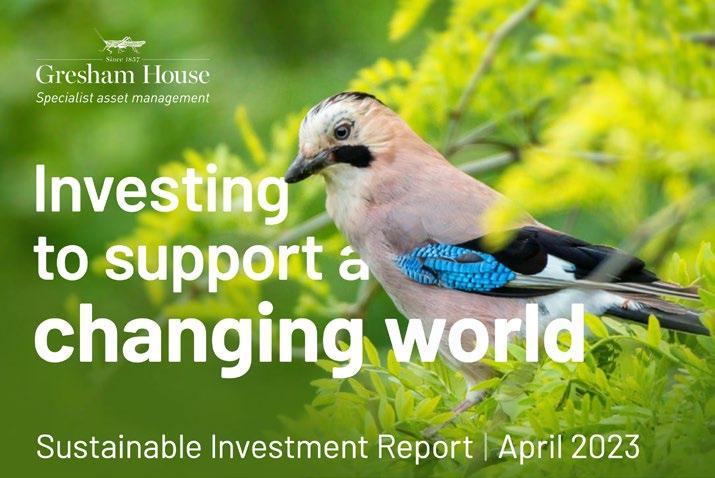
Investors might wish to report on their community engagement in contractual and public documents, such as investor and annual reports, as well as in their thought leadership, to continue signalling their commitment to community engagement. Some investors, particularly those who expect to conduct regular community engagement, might seek to
formalise their community engagement approach, commitment and/or policies in a public document to further increase trust and transparency.41
Community engagement can often produce effective case studies to be used as part of these documents. It is, however, essential that the spotlighted community engagement has been delivered with integrity to avoid accusations of tokenism or “communitywashing”. Examples of effective case studies integrated in investor reports are included below for inspiration.
Rather than delivering community engagement directly, many investors choose to take an influencing, or stewardship role, in community engagement. In such a role, the investor aims to influence the relevant intermediaries (for example an underlying fund manager or the management of an investee company or asset) towards better community engagement practices.
Engaging with communities indirectly is usually a simpler process that requires fewer resources. It does nonetheless require thoughtful probing of the intermediaries who will be doing the community engagement.
Investors such as asset owners who outsource the management of their funds can make clear their expectations that their fund managers, and other actors such as investment consultants, take a proactive approach to community engagement. These can be included as considerations in mandate searches and in engagement with prospective or existing fund managers. Where possible, fund managers should be encouraged to follow
the steps in sections 3.1 and 3.2 above to ensure they adopt an effective community engagement approach.
To start the conversation, below are specific questions that can be raised with fund managers:
• How are the needs of local communities reflected in the fund’s strategy? Specifically, what is the fund’s approach to community engagement? How was it developed? How does it compare with the recommendations of this guide?
• Has the fund integrated community engagement into existing processes used to assess, monitor, manage and exit investments? Does community engagement feature in the fund’s due diligence process with prospective investees? If applicable, is it part of its broader ESG or IMMR approach?
• What metrics are used to assess performance on community engagement? Are these quantitative, qualitative or both?
• How often does the fund report on performance regarding community engagement?
• How is community engagement resourced? Does the investee have skills and expertise inhouse or an external specialist that supports and advises them on community engagement?
More often than not, investee companies and assets are likely to have some processes for community engagement in place, for example within their CSR strategy. Companies and assets operating in highly regulated sectors such as real estate and infrastructure are likely to be more experienced with community engagement. Companies that are undergoing a transition, for example those in highly emitting industries, might also be conducting community engagement as part of their transition planning.
While the present guide is primarily targeted towards investors, it might be helpful to other managers of investee companies and assets to further enhance and deepen their community engagement approach.
The following questions can be useful to assess and monitor the level of community engagement undertaken by existing or prospective investees:
• How do the needs of local communities factor in the investee’s operations?
• Does the investee have a community engagement process?
• Does the process follow good practice (it might be useful here to draw on the step-by-step guide in the section above and the pitfalls in section 4.2)?
• Has the process been in place since the outset of the company or the project?
• Is the process reviewed and updated at least annually?
• What evidence is there that engagement has informed the investee’s plans and decisions?
• Does the investee regularly report on community engagement performance, for example as part of its ESG or impact reporting?
• What metrics are used to assess performance on community engagement? Are these quantitative, qualitative or both?
• What resources and budget has the investee allocated to community engagement? Does the investee have skills and expertise inhouse or an external specialist that supports and advises them on community engagement?
Indirect community engagement does not mean it is not active. Resonance, a social impact property fund manager, as part of its Plymouth investment portfolio, has encouraged and supported investee companies to engage relevant communities in ways that are complementary and can be mutually leveraged.
For example, Resonance has worked with Nudge, a hyper-local community development initiative to redevelop Union Street. Such a focused investment has helped to engage people who have a strong interest in that locality and who might usually not participate in the development or redevelopment strategies if defined at a city level. With support from Resonance, Nudge run regular community engagement events and activities.
Resonance also works with Real Ideas, a social enterprise that has redeveloped multiple locations in Plymouth with a focus on serving particular user groups and needs whilst improving specific locations.

Resonance has further supported ground-up engagement through Memory Matters. Memory Matters has asked people with dementia in the city what would be useful to them and where before launching their memory café. This meant that they were offered large amounts of donations to create different zoned areas within the café representing different decades which was used to create the space their eventual customers wanted.
Resonance sees such engagement as a win-win scenario, as it helps the investor to develop a deeper understanding of the place while helping its investees implement and improve their approach to community engagement, which in turn benefits their own business operations.
Investors looking to develop a community engagement approach should be aware of commonly encountered pitfalls. These pitfalls can result in the benefits of engagement being dampened or, in some cases, negated.
Pitfall
You are asking for input on something for which a decision has already been made.
A good community engagement process makes a difference – to participants, to investors, and to projects. Community engagement should take place while the questions you are asking members of the community are still at a formative stage. A final decision on these issues should not have yet been made or predetermined. This will also help to avoid perceptions that the community engagement exercise is tokenistic and/or “community-washing”.
You don’t know what you will do with the outputs of an engagement process.
There is not sufficient time or resource allocated to allow for meaningful engagement.
There should be a clear decision that your community engagement process will feed into. A well-defined purpose enables you to ensure that the right mechanisms are in place to transform the process outputs into outcomes. You should allow adequate time for an engagement process to happen, so you do not get the results too late for them to be conscientiously considered.
There must be sufficient opportunity for community members to participate in an engagement initiative. Community members need to know about events with enough notice to be able to attend. Participants need to be allowed to digest and reflect on the information they received during events. It is also important to think about resources, such as for example travel costs, that can help make an event accessible. Expenses should be covered at the very least so that participants are not out of pocket for participating in an engagement process. You may go further and offer a thank you gift or honorarium for participants.
1 Pitfall 2 Pitfall 3The outcomes of the engagement process are not fed back to the participants.
There is a common misconception that a good response to community engagement is to do everything that the community says. A good response should instead conscientiously consider what the community says and provide a response to them about what you are doing, what you’re not doing, and why. There are two key factors for consideration. Firstly, you should be clear at the start of the engagement about what is open to change and what isn’t, so you’re not asking people to feed back on things that aren’t open to change. Secondly, you should do the engagement with the genuine intention to listen to what people are saying. It is surprisingly common for people who have done engagement well and have conscientiously considered the outputs not to have communicated the outcomes to the participants, who erroneously feel they have not been listened to. This last step of closing the feedback loop shouldn’t be forgotten.
It might be tempting for investors to see community engagement as a reactive exercise, for example as part of damage limitation following negative scrutiny of an investment. To unlock all the benefits of community engagement, it should be done ahead of such situations arising. There are also examples of community engagement that originated in damage limitation following a crisis becoming an established longer-term approach, as the community engagement practices become more familiar and part of the company’s regular process.
Organisational arrangements to support community engagement are not in place or insufficient.
Meaningful community engagement requires commitment and resourcing and, for most investors, invites a re-think of business as usual. As a starting point, investors seeking to do community engagement should ensure there is sufficient consistency and investment in internal structures to support this work and lead to constructive community relations. Ideally, there should be a team formed and trained to engage communities. This team should be given sufficient autonomy and resources to negotiate and make decisions, access information and contact people throughout the organisation. As the investor’s confidence in engaging communities increases, the team can then be expanded and/or replicated in other parts of the business. In all cases, investors doing community engagement should ensure that they have the right capacities to fulfil the “promise to the public” that is associated with their public participation. Putting in place capacity to respond and implement identified change should be a key consideration.
Pitfall 4 Pitfall 5 Waiting for a crisis to arise before doing community engagement. Pitfall 6
This section provides a selection of case studies that can be drawn upon by investors seeking to engage communities, mapped against specific public participation goals.
The case studies in this section offer a broad, but not exhaustive, view of the fast-evolving practice of community engagement in the UK and globally. The case studies are further mapped to the public participation goal of the engagement (see Spectrum of Public Participation in section 3.2).

The Schroders Capital UK Real Estate Impact Fund aims to address social inequality in the UK and deliver a riskadjusted financial return. By investing in affordable and social housing, town centre regeneration and supporting increased employment, the Fund aims to deliver a positive impact on people, place and planet, focusing on deprived areas of the UK.
As part of its strategy, the fund emphasises how hearing and responding to the community voice is important to meet the needs of local communities. Community engagement is facilitated through longterm stakeholder collaboration and needs-based analysis. The investment
and asset management phases include early and regular community engagement through a range of methods including consultations, information collection, and forums to provide feedback.
This engagement is also used to qualitatively measure the social impact of investments once the projects are in use. The outcomes form the narrative element of the Fund’s annual social impact report alongside quantitative metrics, undertaken by an independent social value consultant, to assess objectively how the fund is progressing towards achievement of its impact objectives.
Astarte in partnership with its platform member Yoo Capital Investment Management (YCIM), have sought to create positive community impact in Shepherd’s Bush Market, a 109-year-old market situated in the heart of west London. After becoming the majority owner of the market in 2020, YCIM launched an active programme of community consultation as part of the preparation of a proposal for the redevelopment of the market and its adjacent sites. A consultation was conducted via drop-ins, online engagement, and a series of workshops and one-on-one meetings with market traders. A total of 33,000 people were invited into the drop-in events. The community’s feedback helped to shape the proposal,
comprising of a redeveloped market as well as new housing and business premises in adjacent sites, that was submitted to the local authorities.
The broader outreach programme includes sponsoring school events, giving space to charities, and working with local organisations to coordinate community efforts. YCIM have also worked with an external firm, appointed to manage Shepherd’s Bush Market, to launch a ‘High Street Incubator’. The incubator is the first of its kind in London and offers free training to existing traders and Londoners with business ideas, as well as access to small format affordable trading space and ongoing support to businesses actively trading in the market.
Gresham House is a specialised asset manager. Among its investments are forests it manages in the UK, Australia, and Ireland on behalf of various investors, including institutions, family offices, private clients, and funds. Gresham House purchased a 3,450-acre site in North Ayrshire, Scotland to establish a sustainably managed productive forest that included diverse species, peatland restoration, access for local communities, and a run-of-river hydro scheme. Despite the site being poor-quality agricultural land with limited biodiversity, the initial tree planting application and environmental assessment took seven years to approve.
The active involvement of the surrounding communities accompanied this process. During this period, the Gresham House
team and woodland managers met regularly with local groups to discuss all aspects of the scheme. Local community reactions to the site were varied, with access provisions and species diversity high on the list of demands from locals. In response to community feedback, the management team designed a considerable network of paths throughout the forest and replaced a key footbridge on the footpath network to support community access and recreation. It also planned the forest to incorporate a wide range of tree species to improve the biodiversity of the site, well above the requirements of forestry standards.
The forest is now being developed following approval. Trees are in their establishment phase, and the hydro scheme is being expanded to generate more renewable

energy for the local area. Access requirements are constantly being discussed and developed with a Local Access Group, with whom the Gresham House team have built a strong working relationship.
In 2022, the Forestry division’s asset and woodland managers had over 140 interactions with local communities, reflecting the commitment to address local communities’ views, where appropriate and to the extent possible, in their forestry activities. The team’s commitment is to include local communities in all forest development and management actions, engaging them throughout the process and trying to provide for as many competing interests as possible while still ensuring the delivery of investment strategies for their clients.
Resonance is a pioneering social impact property fund manager managing a total of over £350m. In 2022, Resonance launched Resonance Community Developers, with £9m in funding from Big Society Capital and the Access Foundation. This social impact fund is designed to help communities meet local needs by creating and owning incomegenerating assets, such as affordable homes, sports and leisure facilities and renewable energy generation. The target fund size is £100 million, with a target return of 4% and a minimum five-year term. The fund has made initial investments in community projects across three areas of the UK, in Cornwall, Gloucestershire and the North West.
The fund follows a strategy of community engagement through the alliance forged with community groups, such as a local Community Benefit

Society, a type of social enterprise that reflects commitment to the wider community, with profits being ploughed back into the business. It supports these groups at every stage of their journey, including establishing themselves, engaging with their wider community and bringing to life their project ambitions, with both finance and sector expertise. The Resonance team, together with Associates, work with these community groups through close co-operation and support, engaging with them through face-toface meetings, workshops, and online consultation. Many community-based organisations do not have the benefit of full-time staff. They are often made up of volunteers and are therefore reliant on the Resonance team. This engagement process is continual, even after the project is completed, enabling Resonance to work with the organisation on impact measurement and new projects.

The Ujima Fund is a social investment fund that sets out to empower and finance Boston’s Black, Indigenous and other People of Colour (BIPOC) entrepreneurs, most specifically where there is a severe racial wealth gap. The fund demonstrates a vision of a community-controlled economy through popular education. It pools investments from institutional investors, Boston residents and other individuals from outside of the city. In 2021, Ujima raised $4.5m of investment capital and has invested approximately $1 million across six different businesses.
The fund has two governing bodies that oversee investment activity: the Community Standards Committee, responsible for setting investment priorities, and the Investment Committee, which prepares recommendations to

present to the voting members. These committees include current and displaced working-class residents, grassroots partner organisations, community business owners and their employees.
The fund supported a community development fund acting as a pillar for economic development and social justice initiatives in Boston’s Roxbury neighbourhood. Local residents were engaged in assemblies both at neighbourhood and citywide levels, creating community-led plans for the fund.
The fund partnered with community organisations to provide loans, investments, and technical assistance to help businesses and organisations succeed. Communities had complete control over the design of the funds being created, from the partnerships made to legal designation. Additionally,
the convening of business leaders and development of a ‘communityapproved’ business network helped gather information about the financing needs in the community as a means of influencing investment tools. Examples of businesses supported include Cero, an organic waste management service, as well as Comfort Kitchen and Kush Grove Clothing, who received up to $200,000 in loans to support their work and mission.
The Ujima Fund gave citizens more voice and decision-making power and helped to increase access to capital for businesses and organisations in the Roxbury neighbourhood of Boston. This led to job creation and further economic development. Even with the high level of control ceded to the community, investors still earned a good risk-adjusted return.
Barking and Dagenham Giving (BD Giving) was set up in 2020 to give local people more opportunities to participate in local decision-making. Funding and investment decisions are made by residents to achieve social good in one of the most deprived and diverse boroughs in England. BD Giving provides funding to local businesses and non-profits.
While there are a growing number of impact-first social investors in the UK, BD Giving is the first to adopt a 100% community-led investment decision-making process. The Community Steering Group (CSG) advises BD Giving and is organised into a peer learning group. The group
are all women – some are People of Colour, mothers, local business owners – each member brings unique professional and personal experiences, while having agreed on a set of shared values. All are residents of Barking and Dagenham.
The CSG designed an investment policy for the community that balances impact, risk, and return in investing. BD Giving recently selected Snowball, an impact fund, for its first investment. They have also launched an investment vehicle for local community enterprises - the GROW Fund - with the ambition to scale the BD Giving model while remaining true to their values.
The REAL People’s Fund is a $10m fund, investing in BIPOC-owned businesses in the East Bay of California. The fund is a community capital fund, designed and developed by six grassroot organisations aiming to provide equitable access to capital. Its structure allows for a collaboration of various organisations: Community Vision, a community development finance institution (CDFI), underwrites and administers larger loans, Uptima Entrepreneurship Cooperative provides technical assistances to businesses, and the Runway Project gives access to early-stage financing.
The fund is community-based and has a BIPOC-focused leadership, incorporating their expertise to empower marginalised communities. Community members can invest in the fund from $100, at 3% interest. Community investors elect a member to the board. Further community engagement is supported through focus groups, surveys, and public meetings. The REAL People’s fund has increased access to capital for small businesses and community organisations – supporting the East Bay area. The fund reported an average return on investment of 9% for its investors.
An investor guide for engaging communities in place-based impact investing

The below checklist summarises the key steps in planning, delivering and sustaining community engagement, as well as key questions that investors should ask themselves at each stage of the process.
Familiarise yourself with the characteristics of successful community engagement: How does your engagement reflect the characteristics of appropriateness, continuity, additionality, collaboration, inclusion, reciprocity, transparency and accountability?
Identify your role in community engagement: Do you want to engage with communities directly or through others?
Define the purpose of the engagement: Are you developing an investment strategy? Do you want to inform sector or thematic plans? Are you looking for input for specific investments?
Set the goal for the engagement: Is the goal to inform, consult, involve, collaborate and/or empower the community?
Define the scale of the engagement: What is the extent of your engagement and how many stakeholders can you involve?
Identify the expected outcomes and outputs of the engagement: What difference will the community engagement make? What are the specific insights you are looking to gain? How will these be captured?
Set the timescales for the engagement: How much time are you looking to allocate to the engagement?
Gather information prior to the engagement: What information is already out there about the place you are looking to engage? What have others done before you?
Allocate resources: What is your budget and internal capacity? Are there any additional resources you might use?
Define how you will measure success: Have you set KPIs? Which qualitative and/or quantitative metrics will you use?
Decide who to engage: Are you engaging all those who will be affected by the decision? Are you including hard to reach and underrepresented communities? Are
you offering financial compensations for participants? Are there any accessibility issues with your engagement method?
Identify partners: Can you engage with the community directly? Would it be more suitable to engage through community representatives or community organisations? Can you get local businesses, authorities, and universities involved?
Decide on your method of engagement: Does your method reflect the specific needs and circumstances of the engagement? Are you engaging digitally or inperson? Can you combine methods?
Communicate with communities: How are you communicating with the community engaged? Which channels are you using? Are you making your language clear and accessible? Are you encouraging two-way dialogue? Are there any local champions to amplify key messages? Are you closing feedback loops appropriately?
Make your engagement sustainable Have you integrated community engagement into existing processes for assessing, monitoring, and managing investments?
Communicate externally: Are you avoiding tokenism and “community-washing” when communicating publicly about your community engagement?
Do community engagement through others effectively: Have you made your expectations on meaningful community engagement clear to those doing community engagement on your behalf, fund managers, investees and assets? Are you monitoring success?
Avoid common pitfalls:
Ask for community input only if a decision has not already been made.
Know what you will do with the outputs of an engagement process.
Allocate sufficient time or resource allocated to allow for meaningful engagement.
Feed back the outcomes of the engagement process to the participants.
Do not wait for a crisis to arise before doing community engagement.
Make sure organisational arrangements to support community engagement are in place and appropriate.
A number of organisations specialise in different forms of community and public engagement. For investors who do not have these skills in-house, such organisations can help plan, deliver and/or evaluate community engagement.
Examples of organisations who can provide support include:
• The Good Economy: The Good Economy is an impact advisory firm with expertise in place-based impact investment approaches, including a series of ‘PBII Labs” to road test these approaches and bring together multiple place-based stakeholders to the benefit of specific places.
• The Involve Foundation: The UK’s leading public participation charity. Since 2003, Involve has worked with governments, parliaments, civil society, academics and the public to create and deliver new forms of public participation that revitalise democracy and improve decisionmaking. Involve has a network of organisations and freelancers with a range of specialisms from delivery to evaluation and can put out calls through its networks for specific areas of support.
• Mapping for Change: Mapping for Change works with groups and organisations who want to understand, improve and produce information about the places that matter to them. Mapping for Change offers a range of participatory mapping services to voluntary and community groups, business organisations and government bodies.
• Migrant’s Bureau: Migrant’s Bureau is a social design and urbanism practice focused on engaging with immigrant and migrant communities. Migrant’s Bureau focus on interventions to support engagement with the communities to build and design playgrounds, community spaces and housing.
• New Citizenship Project: New Citizenship Project is a strategy and innovation consultancy that works with different types of organisations to create participatory strategies, cultures and projects that invite people to step into their power as citizens. New Citizenship Project use experience in creative strategy, social psychology, behavioural theory, design thinking, academic research, economic democracy, creative production
and digital practice to craft creative interventions that prompt authentic shifts in how organisations work with people.
• Plunkett Foundation: Plunkett Foundation is a national charity working to create resilient, thriving and inclusive rural communities throughout the UK. To achieve this, the Foundation supports people in rural areas to set up and run a wide range of businesses which are genuinely owned by local communities, whereby members have equal and democratic control.
• Shared Future: Shared Future is a Community Interest Company based in Northwest England that works on community empowerment, the social economy and democratic participation. Shared Future plan and deliver deliberative and participatory processes.
• The Social Investment Consultancy (TSIC): TSIC is a global social impact consultancy, partnering with its clients to create an equitable society that puts impact first. TSIC specialise in social impact measurement, social investment and diversity, equity and inclusion strategies, including strategies for community engagement.
• Social Value Portal: Social Value
Portal is a B-Corp operating a platform to procure, measure, manage and report social value as defined in the National TOMs (Themes, Outcomes and Measures), a widely recognised framework. Social Value Portal also offers dedicated place-based services, focused on helping interested parties identifying local needs, engage communities and building a strategy to boost social value creation.
• The Sortition Foundation: The Sortition Foundation can manage participant recruitment for community engagement processes. The Sortition Foundation offers bespoke selection and stratification services for investors looking for a mini public style event.
• TPXimpact: TPX delivers digital outcomes that aim to make a difference to how people experience the world. One of their services is planning and delivering deliberative processes.

1 For examples of community engagement outside of PBII, the Impact Investing Institute’s website provides a series of case studies on funds reflecting community voice in different asset classes in private and public markets. See Impact Investing Institute (2023): Just transition finance case studies
2 Impact Investing Institute (2021): White Paper: Scaling up institutional investment for placebased impact
3 HM Government (2022): Levelling up the United Kingdom The LGPS comprises 99 regional pension funds, often referred to as “LGPS funds” or “local authority pension funds”.
4 Legal & General (2022): Legal & General announce £4bn investment commitment, working in partnership with West Midlands combined authority;
5 Schroders Capital: Schroders Capital UK Real Estate Impact Fund;
6 Igloo Regeneration: Chrysalis Fund, Liverpool;
7 Good Governance Institute (2020): Defining communities;
8 International Association of Public Participation (2018): IAP2 Spectrum of Public Participation
9 This is not to say that activities towards the Inform goal should be seen as a mere fulfilment of statutory requirements. Activities to “Inform” should aim to provide the community with balanced and objective information to assist with understanding the problem, alternatives, opportunities, and/or solutions that the investor is seeking to address. Engagement towards this goal should be impartial and where possible should provide information from different perspectives. See Involve’s website for further resources and associated methods towards the Inform goal.
10 People Powered (2022): Impacts of participatory budgeting: what we know;
11 Wrobel, B. and Massey, M. (2021): Letting Go: How Philanthropists and Impact Investors Can Do More Good By Giving Up Control;
12 Just Transition Participatory Budgeting Fund: Funding for green projects in your community - Aberdeen, Aberdeenshire & Moray. This fits into the Scottish Government’s statutory requirement of at least 1% of local budgets being in scope for participatory
budgeting. See COSLA and Scottish Government (2021): Community Choices: Participatory Budgeting in Scotland Framework for the operation of the 1% target for Local Authorities (2021 Update)
13 Alexander, J. (2023): #CouncilCulture: How can we really shift the relationship between councils and citizens?;
14 In the UK, a country-wide survey conducted by Commonplace highlighted that 76% of respondents thought that ‘people need to be given a greater say over new developments in their local area. See Commonplace (2022): Engaging for the Future;
15 UNCTAD-World Bank (2018): Community Engagement Strategies in RAI Knowledge Into Action Notes;
16 For example, the BlueOrchard InsuResilience Fund aims to help increase the resilience of smallholder farmers in developing economies to the effects of climate change by investing in providers of micro-income protection insurance providers. Working with 60 Decibels, a tech-powered impact measurement company, the fund regularly surveys the end-customers in target areas to ensure that micro-insurance products are adapted to their needs and affordable. See Impact Investing Institute (2023): Just transition finance case studies
17 UNCTAD-World Bank (2018): Community Engagement Strategies in RAI Knowledge Into Action Notes For broader insights into the benefits of community engagement (e.g. customer perception and consumer loyalty, better understanding of consumer market and consumer preference and better access to employee talent) see Harvard Business Review (2020): When Community Becomes Your Competitive Advantage; Silvia Avasilcai and Gabriela Rusu (2015): Innovation management based on proactive engagement of customers: A case study on LEGO Group); and Faree Naz (2022): Role Of Community Partners As An Integral Element Of The Talent Pipeline);
18 See See Gutterman, A (2019): Community Engagement and Investment: Supporting Your Client’s Sustainability Initiatives for an overview;
19 In the corporate social responsibility (CSR) literature, this concept of acceptance granted to a company or organisation by the community is often referred to as the “social licence to operate”.
20 Financial Times (2023): Greta Thunberg accuses Norway of ‘green colonialism’ over wind farm;
21 See National Social Value Taskforce (2022): Embedding social value into planning;
22 Adapted from Walker, P. (2019): DAD and EDD: Two approaches to engaging stakeholders in decisions;
23 Tony Blair Institute for Global Change (2023): Building the Future of Britain: A New Model for NationalInfrastructure Planning;
24 Sleaford Renewable Energy Plant: Community benefits;
25 Impact Investing Institute: Just Transition Finance Challenge;
26 These characteristics were identified based on existing literature, including National Coalition for Dialogue & Deliberation et al., (2009): Core principles for public engagement WWF (2021): Transforming cities together; Citizens Advice Scotland (2020): Engaging hearts and minds; Baker, S. (2022): A scoping review of place-based approaches to community engagement and support. Welsh Government, GSR report number 43/2022; Involve: How do I plan a participatory process?; Scottish Community Development Centre (2015/16): National Standards for Community Engagement. They were further refined through engagement with PBII investors as well as Community Cuppas participants.
27 See Public Health Wales: Principles of Community Engagement for Empowerment for an exploration of potential unintended consequences of community engagement and how to mitigate them.
28 See Criterion Institute (2020): Process Metrics that Analyze Power Dynamics in Investing for a practical guide on how to approach and measure power dynamics in an investment context.
29 Oxfam (2019): The Demand Side of Impact Investing: Elevating the perspectives of local entrepreneurs in the impact sector;
30 UCL: Prosperity in east London
31 SYPA (2023): Consultation, Communications and Engagement Strategy;
32 It is good practice to offer the option of vouchers instead of cash or bank payments, as received compensation might affect benefits. The option not
to accept the payment should also be given. The compensation rate should be roughly equivalent to the real living wage per hour.
33 Involve: How do I plan a participatory process?;
34 Legal & General (2023): Public consultation launches for new £1.7bn innovation district ID Manchester
35 Involve: Methods; Participedia
36 Newham London (2022): Royal Docks Corridor Community Engagement Report;
37 Commonplace (2022): Social Media and Community Engagement in Catford Island;
38 See Involve: Where do I start with digital engagement? for a practical handbook;
39 See Saxon Court for an example;
40 Global Reporting Initiative (2016): GRI 413: Local Communities; GIIN (2021): IRIS Community Engagement Strategy (OI2319); Social Value Portal: National TOMs For a comprehensive list of community engagement-related indicators in commonly used standards and frameworks, see Impact Investing Institute (2023): Just Transition Criteria
41 See Grosvenor: Creating a more Positive SpaceOur Community Charter;
42 Schroders Capital: Schroders Capital UK Real Estate Impact Fund;
43 Shepherd’s Bush Market: The Future;
44 Gresham House (2023): Sustainable Investment Report;
45 Ujima Boston;
46 Barking and Dagenham Giving;
47 The REAL People’s Fund;
The development of this guide has been supported by the Place Coalition, an advisory group that brings together mainstream investors, social investors, developers, place practitioners, local authorities, and partner organisations. We would like to thank DCMS for their funding and support for this project and for the place-based impact investing agenda more broadly. We would also like to extend our thanks to everyone who attended our “Community Cuppas” - three community engagement events that were held in the North of Tyne area (Hexham, Newcastle and North Shields).
We are also grateful to the investors and other organisations who have supported the drafting of case studies on their practices. Particular thanks goes to Transform Finance, which has extensively documented leading practices in community engagement in a PBII context and provided invaluable materials for our own research.
Thanks also go to the investors, community engagement experts and other practitioners who have provided feedback on successive iterations of this guide, including Bonnie Chiu, Managing Director - The Social Investment Consultancy; Dave Thornett, Business Development Manager - The Key Fund; Gabriella Peerman, Assistant Portfolio
Manager, Real Estate - Schroders Capital; Ged Devlin, Development Manager - The Key Fund; Jonathan Digges, Chief Investment OfficerOctopus Investment; John Alker, Head of Sustainability - Legal & General Capital; Leila Sharland, Senior Investment Manager, Deputy Head, Growing Enterprises - Resonance; Liam RonanChlond, Head of Engagement - Socius; Lydia Merry, Manager, Real Estate Capital - Schroders Capital; Martin Wood, Senior Researcher - New Economics Foundation; Matt Smith, CEO - The Key Fund; Matthew Soffair, Senior Research Manager, Real Assets - Legal & General Investment Management; Reema Patel, Research Director and Head of Deliberative Engagement - IPSOS; Sam Monger, Senior Associate - The Good Economy; Vasudha Rajain, Associate, ESG & Climate Finance - Astarte Capital Partners; William Ixer, Senior Policy Advisor, Impact Investing – DCMS.
Contributors
Impact Investing Institute
David Krivanek, Senior Programme Manager; Jamie Broderick, Deputy Chair and Lead Expert PBII; Julian Arevalo, Intern; Kieron Boyle, CEO; Lizzy Robins, Events Manager; Mark Hall, PBII Programme Manager; Mere Wolfensberger, Intern; Riah Knowles-Brock, Civil Service Fast Stream secondee; Roisin Cogan,
Civil Service Fast Stream secondee; Sarah Teacher, Executive Director; Steffi Dawoud, Communications and Engagement Manager; Yinka Johnson, PBII Programme Coordinator.
Involve
Carly Walker-Dawson, Head of Capacity Building; Hally Ingram, Senior Associate; Sarah Allan, Director of Capacity Building and Standards.
Community participants in Hexham, Newcastle and North Shields.
Toast Design; Joe Haydon Photography.
The production of this guide has been an iterative and collaborative endeavour. We continue to welcome feedback on the guide and further cases studies of best practice of community engagement in the field of impact investing. Feedback can be submitted to place@impactinvest.org.uk
Impact Investing Institute (2023):
Fostering Impact: An investor guide for engaging communities in place-based impact investing
